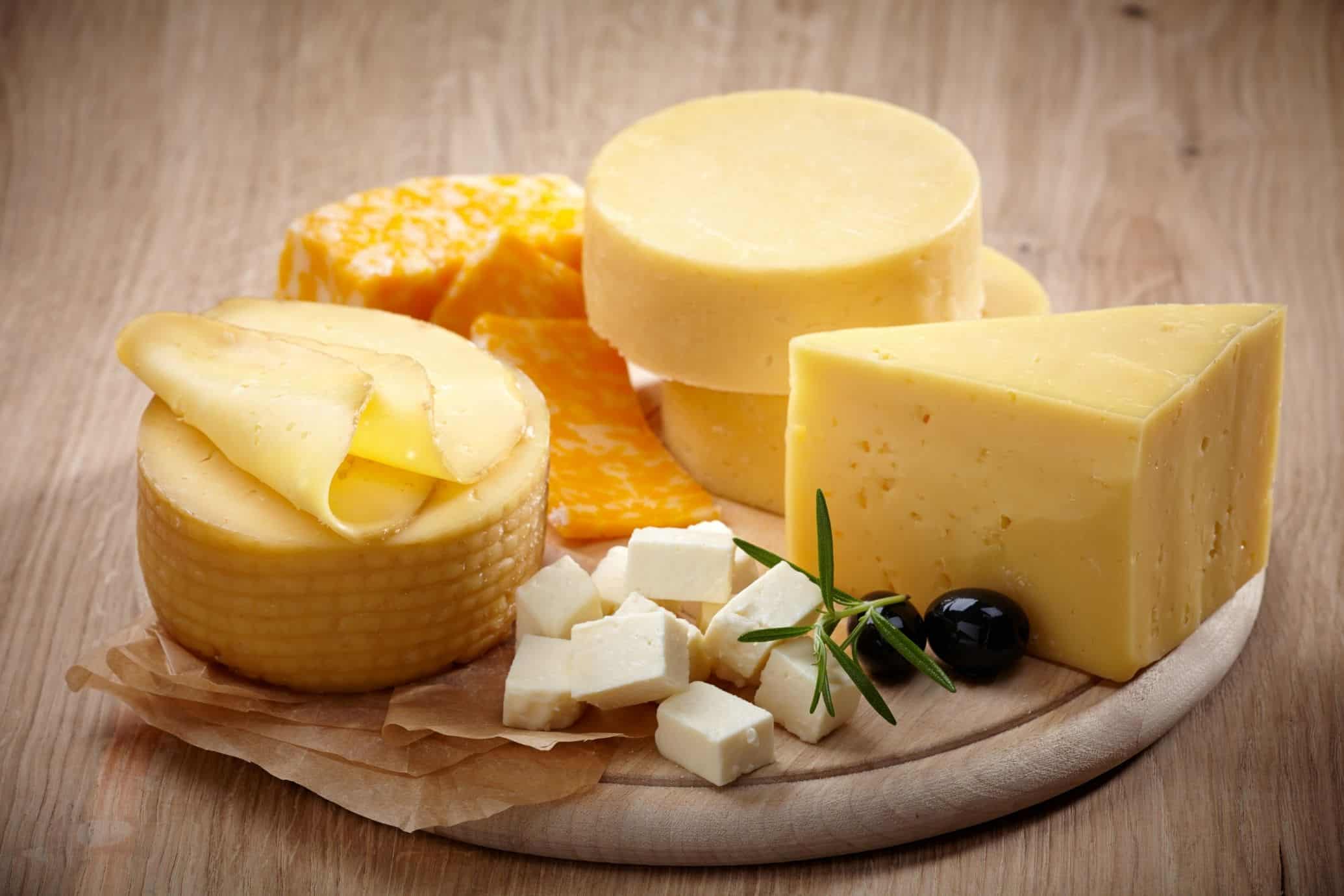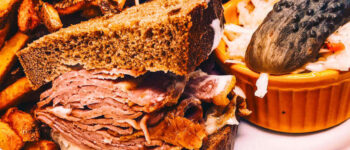↵ View All Produce Conversions
It can be hard to figure out how much cheese you need to buy to meet some recipe’s requirements. If a recipe calls for a cup of shredded cheese or a cup or cubed cheese how much cheese do you need to buy? It all comes down to how much in a pound of cheese shredded or cubed.
To determine how much is a pound of cheese cubed or shredded we selected a 1/4 pound block of cheese for our test sample. These measurements are the same for cheddar, mozzarella, American, Swiss, jack, and other processed block cheeses.
We found that our 1/4 pound block in our sample size equals 2/3 cup of cubed cheese. If you have a full 1 pound block equals 2.67 cups of cubes. When grated, our 1/4 pound block of cheese yielded 1 cup of shredded cheese, or 4 cups from a 1 pound block of cheese.
Bleu cheese is normally crumbled, not grated or cubed but we found that 1/4 pound still equaled 1 cup. Parmesan cheese is slightly different than the previously mentioned cheeses. One pound of this cheese equals about 4.5 cups grated which makes 1/4 pound come in at 1 to 1.25 cups grated.
If you are measuring by weight, remember that coarsely grated cheese is much heavier than finely grated cheese. In other words 1 cup of coarsely grated cheese will contain less cheese than 1 cup of finely grated cheese. Most good recipes will specify what grating size they used.
Did you know that it takes about 10 pounds of milk to make 1 pound of cheese. Cheese can be produced using cow, buffalo, goat, horse and even camel milk. Moose milk cheese that is made on a farm in Sweden is super rare, super expensive; it sells for about $400 per pound. However, the most expensive cheese in the world is called Pule, a Balkan donkey milk variety from Serbia that cost $600 per pound. Since cheese is most flavorful when eaten at room temperature, remove it from the refrigerator about 1 to 1.5 hours before serving.

So now whether you need shredded or cubed cheese you’ll be able to easily figure out how much is in a 1/4 pound of cheese. You can also use our conversion tool below for any custom how many cups in a… measurements you need. If you use a lot of cheese you should consider getting a good box grater, and microplane. I often use a box grater for basic cheese shredding. There are several inexpensive models that do the trick OXO Good Grips and the iCooker Stainless Steel Cheese Grater are 2 good examples to consider. In addition to zesting, a microplane makes quick work of producing very fine grated Parmesan cheese. For many years I have used the Microplane Classic Zester/Grater at home. If you are looking for a great gift for a cheese lover? Consider the Victorinox Swiss Army 3-Piece Gourmet Cheese Knife that includes a one for each type of cheese.
Custom Conversions for ¼ Pound Cheese Block
One ¼ Pound Cheese Block Equals
- There is ⅔ Cup (158 mls) of Cubed Cheese in a ¼ Pound Cheese Block
- There is 1 Cup (237 mls) of Shredded Cheese in a ¼ Pound Cheese Block
See more : What to Serve with Baked Beans: 50 Delicious Recipes
I need: ¼ ½ ¾ 1 1 ½ 2 2 ½ 3 3 ½ 4 4 ½ 5 6 7 8 9 10 Teaspoon(s) Tablespoon(s) Fluid Ounce(s) in Volume Cup(s) Pint(s) Quart(s) Gallon(s) Milliliter(s) Liter(s) of Cubed Cheese Shredded Cheese You need 1.5 ¼ Pound Cheese Blocks
Want a Fancy Cocktail?
Full Recipe: Smoked Manhattan Cocktail
How to Store ¼ Pound Cheese Block
General How to Store Cheese Info
Cheese is usually categorized into four types: soft, semi-soft, semi-hard and hard. The designation refers to the amount of moisture in the cheese, which directly affects its texture.
Soft cheese includes cottage cheese, cream cheese, ricotta, brie, bleu, roquefort, mozzarella, meunster and similar cheeses. American, Colby, co-jack and similar cheeses are in the semi-soft category.
Semi-hard cheeses include cheddar, provolone, gouda, Jarlsberg, etc. Hard cheeses include parmesan, romano, asiago, Swiss, Gruyere and others.
General Cheese Info
Cheese is usually categorized into four types: soft, semi-soft, semi-hard and hard. The designation refers to the amount of moisture in the cheese, which directly affects its texture.
Soft cheese includes cottage cheese, cream cheese, ricotta, brie, bleu, roquefort, mozzarella, meunster and similar cheeses. American, Colby, co-jack and similar cheeses are in the semi-soft category.
Semi-hard cheeses include cheddar, provolone, gouda, Jarlsberg, etc. Hard cheeses include parmesan, romano, asiago, Swiss, Gruyere and others.
Short Term Cheese Storage
Cheese should be refrigerated. Unopened packaged cheese can be left in the original wrapping, but bulk cheese should be wrapped in wax paper, and then placed in a plastic bag. Cheese stored with this method will remain good for 5 to 8 days.
See more : What is the diet to follow while taking Wegovy?
And hard aged cheeses, such as Cheddar, Colby, Gruyere, asiago, and Manchego, can be stored longer in the refrigerator as they simply continue their aging process.
Cheese Long Term Storage
Thaw frozen cheese in the refrigerator, never thaw cheese on the counter top!
Freeze fresh, soft cheeses, such as mozzarella and goat cheese, in their original packaging, or wrap them tightly in plastic wrap and place inside a ziplock bag before storing it in the freezer. The soft cheeses will maintain their flavor for about 2 months.
Brie, Camembert, and Ricotta cheeses will not freeze very successfully.
Semi-soft cheeses, like Monterey Jack, Munster, Havarti, and Gorgonzola, tend to become crumbly after freezing.
Cream-style cottage cheese can be frozen for 2 to 3 months; however, the taste and texture will be partly affected.
¼ Pound Cheese Block Recipes
Looking for Something a Little Different?
Full Recipe: Citrus Cured Salmon Sous Vide
What is the Produce Converter?
One of the biggest hassles when cooking and working in the kitchen is when a recipe calls for “the juice of 1 lime” or a similar measurement. Often times when cooking people use bottled juices, pre-sliced vegetables and other convenient cooking time savers. Produce Converter will help you convert the “juice of 1 lime” and other similar recipe instructions into tablespoons, cups and other concrete measurements.
Produce Converter can also be used to figure out how many vegetables to buy when you need, for instance, “A cup of diced onion.” You can use our easy conversion tool to figure out exactly how many onions you need to buy at the store in order to end up with the amount you need for your cooking.
We hope you enjoy Produce Converter and if you have any suggestions for how we can improve it and make your cooking easier please let us know.
Nigel Gildon editor:Nigel Gildon is the editor of Chef Wayne’s Big Mamou: Chef Wayne’s Big Mamou. He has worked in the publishing industry for many years and has a passion for helping new authors get their work into the hands of readers. 63 Liberty Street * Springfield, MA 01003






